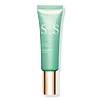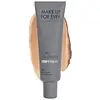What's inside
What's inside
 Key Ingredients
Key Ingredients

 Benefits
Benefits

 Concerns
Concerns

 Ingredients Side-by-side
Ingredients Side-by-side

Water
Skin ConditioningDimethicone
EmollientButylene Glycol
HumectantGlycerin
HumectantPhenyl Trimethicone
Skin ConditioningVinyl Dimethicone/Methicone Silsesquioxane Crosspolymer
CI 77891
Cosmetic ColorantAlcohol
AntimicrobialPEG/PPG-18/18 Dimethicone
EmulsifyingC12-15 Alkyl Benzoate
AntimicrobialSodium Chloride
MaskingSilica
AbrasiveSynthetic Fluorphlogopite
Bisabolol
MaskingParfum
MaskingEthylhexylglycerin
Skin ConditioningDisodium EDTA
Stearalkonium Hectorite
Gel FormingPropylene Carbonate
SolventAluminum Hydroxide
EmollientCI 77492
Cosmetic ColorantCI 42090
Cosmetic ColorantHexyl Cinnamal
PerfumingBenzyl Benzoate
AntimicrobialSodium Lauroyl Glutamate
Butylphenyl Methylpropional
PerfumingPhenoxyethanol
PreservativeLysine
Skin ConditioningAlpha-Isomethyl Ionone
PerfumingMagnesium Chloride
Furcellaria Lumbricalis Extract
Skin ConditioningPancratium Maritimum Extract
BleachingLinalool
PerfumingCitronellol
PerfumingLimonene
PerfumingEugenol
PerfumingCamellia Sinensis Leaf Extract
AntimicrobialTriethoxycaprylylsilane
Lapsana Communis Flower/Leaf/Stem Extract
Skin ConditioningMaris Sal
Skin ConditioningWater, Dimethicone, Butylene Glycol, Glycerin, Phenyl Trimethicone, Vinyl Dimethicone/Methicone Silsesquioxane Crosspolymer, CI 77891, Alcohol, PEG/PPG-18/18 Dimethicone, C12-15 Alkyl Benzoate, Sodium Chloride, Silica, Synthetic Fluorphlogopite, Bisabolol, Parfum, Ethylhexylglycerin, Disodium EDTA, Stearalkonium Hectorite, Propylene Carbonate, Aluminum Hydroxide, CI 77492, CI 42090, Hexyl Cinnamal, Benzyl Benzoate, Sodium Lauroyl Glutamate, Butylphenyl Methylpropional, Phenoxyethanol, Lysine, Alpha-Isomethyl Ionone, Magnesium Chloride, Furcellaria Lumbricalis Extract, Pancratium Maritimum Extract, Linalool, Citronellol, Limonene, Eugenol, Camellia Sinensis Leaf Extract, Triethoxycaprylylsilane, Lapsana Communis Flower/Leaf/Stem Extract, Maris Sal
Methyl Methacrylate Crosspolymer
Dimethicone
EmollientCyclopentasiloxane
EmollientDiphenylsiloxy Phenyl Trimethicone
Skin ConditioningDimethicone/Vinyl Dimethicone Crosspolymer
Skin ConditioningTrimethylsiloxysilicate
EmollientTitanium Dioxide
Cosmetic ColorantPhenoxyethanol
PreservativeSilica Silylate
EmollientParfum
MaskingCI 77492
Cosmetic ColorantLepidium Meyenii Root Extract
Skin ConditioningMagnesium Carbonate
AbsorbentMaltodextrin
AbsorbentPolymethylsilsesquioxane
Aluminum Hydroxide
EmollientTocopherol
AntioxidantCI 77491
Cosmetic ColorantHydrogen Dimethicone
CI 77499
Cosmetic ColorantWater
Skin ConditioningMethyl Methacrylate Crosspolymer, Dimethicone, Cyclopentasiloxane, Diphenylsiloxy Phenyl Trimethicone, Dimethicone/Vinyl Dimethicone Crosspolymer, Trimethylsiloxysilicate, Titanium Dioxide, Phenoxyethanol, Silica Silylate, Parfum, CI 77492, Lepidium Meyenii Root Extract, Magnesium Carbonate, Maltodextrin, Polymethylsilsesquioxane, Aluminum Hydroxide, Tocopherol, CI 77491, Hydrogen Dimethicone, CI 77499, Water
 Reviews
Reviews

Ingredients Explained
These ingredients are found in both products.
Ingredients higher up in an ingredient list are typically present in a larger amount.
Aluminum Hydroxide is a form of aluminum. It can be naturally found in nature as the mineral gibbsite. In cosmetics, Aluminum Hydroxide is used as a colorant, pH adjuster, and absorbent.
As a colorant, Aluminum Hydroxide may add opacity, or reduce the transparency. Aluminum hydroxide is contains both basic and acidic properties.
According to manufacturers, this ingredient is an emollient and humectant. This means it helps hydrate the skin.
In medicine, this ingredient is used to help relieve heartburn and help heal ulcers.
There is currently no credible scientific evidence linking aluminum hydroxide in cosmetics to increased cancer risk.
Major health organizations allow the use of aluminum hydroxide in personal care products and have not flagged it as a carcinogenic risk at typical usage levels.
Learn more about Aluminum HydroxideCi 77492 is also hydrated iron III oxide. It's sole purpose is to give a yellow hue to products.
Iron III oxides are classified as inorganic chemicals for coloring.
Synthetically created Ci 77492 is considered safer than those naturally found. This is because the synthetically created version may contain less impurities. Iron oxides are generally non-toxic and non-allergenic.
Learn more about CI 77492Dimethicone is a type of synthetic silicone created from natural materials such as quartz.
What it does:
Dimethicone comes in different viscosities:
Depending on the viscosity, dimethicone has different properties.
Ingredients lists don't always show which type is used, so we recommend reaching out to the brand if you have questions about the viscosity.
This ingredient is unlikely to cause irritation because it does not get absorbed into skin. However, people with silicone allergies should be careful about using this ingredient.
Note: Dimethicone may contribute to pilling. This is because it is not oil or water soluble, so pilling may occur when layered with products. When mixed with heavy oils in a formula, the outcome is also quite greasy.
Learn more about DimethiconeParfum is a catch-all term for an ingredient or more that is used to give a scent to products.
Also called "fragrance", this ingredient can be a blend of hundreds of chemicals or plant oils. This means every product with "fragrance" or "parfum" in the ingredients list is a different mixture.
For instance, Habanolide is a proprietary trade name for a specific aroma chemical. When used as a fragrance ingredient in cosmetics, most aroma chemicals fall under the broad labeling category of “FRAGRANCE” or “PARFUM” according to EU and US regulations.
The term 'parfum' or 'fragrance' is not regulated in many countries. In many cases, it is up to the brand to define this term.
For instance, many brands choose to label themselves as "fragrance-free" because they are not using synthetic fragrances. However, their products may still contain ingredients such as essential oils that are considered a fragrance by INCI standards.
One example is Calendula flower extract. Calendula is an essential oil that still imparts a scent or 'fragrance'.
Depending on the blend, the ingredients in the mixture can cause allergies and sensitivities on the skin. Some ingredients that are known EU allergens include linalool and citronellol.
Parfum can also be used to mask or cover an unpleasant scent.
The bottom line is: not all fragrances/parfum/ingredients are created equally. If you are worried about fragrances, we recommend taking a closer look at an ingredient. And of course, we always recommend speaking with a professional.
Learn more about ParfumPhenoxyethanol is a preservative that has germicide, antimicrobial, and aromatic properties. Studies show that phenoxyethanol can prevent microbial growth. By itself, it has a scent that is similar to that of a rose.
It's often used in formulations along with Caprylyl Glycol to preserve the shelf life of products.
Water. It's the most common cosmetic ingredient of all. You'll usually see it at the top of ingredient lists, meaning that it makes up the largest part of the product.
So why is it so popular? Water most often acts as a solvent - this means that it helps dissolve other ingredients into the formulation.
You'll also recognize water as that liquid we all need to stay alive. If you see this, drink a glass of water. Stay hydrated!
Learn more about Water